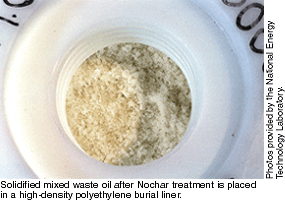|
Solidifying oil with NocharFor over a decade, DOE’s
Mound Facility in Miamisburg,
Ohio has debated about the best way to dispose of reservoirs of tritiated
and heavy metal–laced mixed waste oil that exists at the site. The
long-time use of vacuum pumps that support glove box operations has
produced over 1,700 gallons of oil with an estimated inventory of
50,000 curies. As the debate continued over what to do, a viable baseline
for treatment or disposal was hard to identify. That is, until the testing of Nochar PetroBond® (Tech
ID 2313). Through sponsorship by a DOE technology development group, the Deactivation
and Decommissioning Focus Area, and its Large-Scale Demonstration
and Deployment Project (LSDDP) at Mound, Nochar PetroBond was introduced
to provide a simple and effective disposal method for tritiated oil.
This high-technology, polymer solidifying agent requires no mixing
or mixing equipment. The polymer crystals can be specifically designed
to address the characteristics of mixed waste oil as they exist at
any given site. When demonstrated at Mound during the LSDDP, Nochar PetroBond stabilized
nine gallons of mixed waste tritiated oil in just a few hours. It
met the strict waste acceptance criteria for the Nevada
Test Site and was buried underground there. The demonstration
was a success, and Nochar has now been chosen as the baseline technology
at Mound.
Brunkow estimates that Nochar could save “a million dollars
or more” at Mound compared to other disposal options such as
incineration. Why Nochar was better at MoundBefore settling on Nochar PetroBond, the Mound LSDDP examined various
methods for treating tritiated oils, including incineration, long-term
storage for decay, and solidification with organic agents. The ability to absorb and solidify liquid waste has been around for
many years but has not always been considered acceptable. The old-school
technique of using clay “oil dry” material is unreliable
and inefficient; absorbed volumes are high and have the tendency to
form “islands,” or unabsorbed pockets with free liquids.
Brunkow likens it to the clumping of kitty litter. The difference with Nochar is that its combination of high-tech polymer
crystals absorbs oil efficiently and with little increase in volume.
It can even take on the consistency of rubber with the right formula.
Nochar’s uses vary from free-liquid control in storage and transport
to the disposal of low-level radioactive waste and mixed waste. In
addition to being a ready-to-use “enabling technology,”
Nochar is clean and safe. Its polymer crystals are nontoxic, nonbiodegradable,
and incinerable to less than 0.02% ash with an absorbent capacity
of up to 15:1 (ratio of oil to solidification agent by weight). Nochar
also makes polymer products that address aqueous-based waste material. The future
of Nochar
|

 “There’s
no doubt it’s the technology of choice for mixed waste oil here
in Miamisburg,” says Project Engineer Ward Brunkow. “They
have ordered significant amounts of the Nochar polymer, and it’s
here on their loading docks. It’s just a matter of settling the
logistics before it gets put into complete use.”
“There’s
no doubt it’s the technology of choice for mixed waste oil here
in Miamisburg,” says Project Engineer Ward Brunkow. “They
have ordered significant amounts of the Nochar polymer, and it’s
here on their loading docks. It’s just a matter of settling the
logistics before it gets put into complete use.” DOE
plans to continue deployment of Nochar PetroBond at additional sites.
It’s been tested and is being considered for use at
DOE
plans to continue deployment of Nochar PetroBond at additional sites.
It’s been tested and is being considered for use at